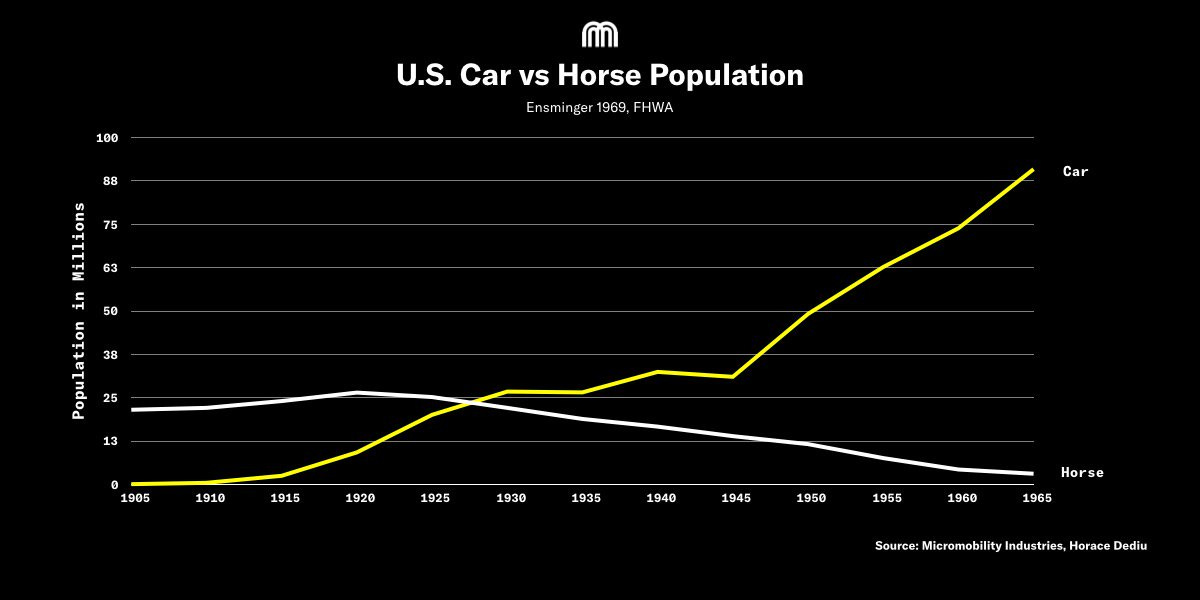Peak horse but for cars 🐎
This week, Uber starts trading, the battle over scooter data continues, and walkable cities may hold the secret to longevity, but first…

Horses in the Front
When did the U.S. reach peak horse, or the highest number of domesticated equines before the total started to decline?
Was it in 1876, after the invention of the first modern internal combustion engine? Or 1892, when the gas-powered tractor was created? Maybe it was 1908, when the original Model T rolled off the line?
The answer is none of the above. The U.S. horse population actually continued to grow steadily during the early 1900s and only maxed out around the end of World War I. Cars didn’t actually overtake colts and mares on the road until the 1920s.
Why is this interesting? Well for one thing, it means the heyday of the horse in America was closer to the age of Gatsby than Jesse James, which is neat.
For another thing, it reveals an important truth about progress: Technology takes time to diffuse.
Despite the superiority of the car as a mode of personal mobility, many things needed to happen before it could disrupt the horse and buggy.
Manufacturing and distribution had to be streamlined, roads had to be updated, traffic rules had to be rewritten, attitudes had to change. All the while, as the car was scaling, horse breeders’ profits continued to tick upward, as if the future of transport hadn’t already moved on without them.
Now, a century later, the same situation is playing out with micromobility. The enabling technologies for lightweight electric vehicles—Li-ion batteries, smartphones, GPS, small, inexpensive motors—are reaching maturity, yet micro vehicles have just begun to make a dent in the trillions of short-distance car trips that are taken each year.
Meanwhile, like horses at the dawn of the 20th century, the U.S. car population is holding steady, if not flagging a bit. Once again, decay lags adoption.
The question is, how long will it take before the horseless carriage goes the way of its predecessor?
**
Finally, in case you were wondering what happened to all those obsolete horses when the Tin Lizzie took off, well…


Yep. Pretty grisly.
Assuming they’re not all turned into bike-sharing stations, what will happen to the one billion automobiles worldwide as micromobility matures?
Tell us on Twitter what you think the car version of doggie chow will be.
🌼 Bye Bye Birdie, Hello Spring Special 🌼
Pump the brakes! Early Bird for Micromobility Europe is officially sold out.
Luckily, if you haven’t booked your spot at the conference yet, there are still plenty of tickets—and savings—left.
For a very limited time, we’re offering over 25% off the General Admission price with our Spring Special discount.
Book now before this deal ends. Like Early Bird, when it’s gone, it’s gone for good.
P.S. Don’t forget, you can save an extra €50 off the Spring Special price by becoming a subscriber of mmm today.
From the Blog
In the newest installment in the “Three Eras of Micromobility” series, Horace looks at the link between transportation and culture to understand why on-demand electric mobility took off in some countries before others.
What micromobility has done, at least, in its short existence, is throw light on our invisible assumptions about transportation. On car dependency. On parking subsidies. On vast over-service of automobility. On bundling of trips in one big metal box.
Read the full article here.
(And if you missed it, catch up on the first part of the series here.)
Airwaves
Over on the podcast, Horace and Oliver look at how micromobility can make cities more resilient to natural disasters.
Listen here.
What You Need to Know This Week
MDS, the L.A.-crafted standard for micromobility providers to share data with cities, is stoking privacy concerns. | Wired
Why Uber’s turbulent first few days of trading may not matter—for now. | Yahoo Finance
Tesla is ignoring micromobility at its own peril. | The Drive
Share, rent, or own? Bird is introducing a new e-scooter, Bird One, which will be available for direct purchase. | The Verge
As shared scooters get heavier to withstand fleet use, personal scooters may slim down to as little as 10 pounds | Trucks
How parents without cars pull it off. | CityLab
In walkable places such as Boulder, Colorado, and Portland, Oregon, people have an extra 20 year life expectancy over less walkable cities like Tallahassee, Florida. | Quartzy
Stay Connected
Be sure to follow us and check out our website for all the latest news and announcements.


